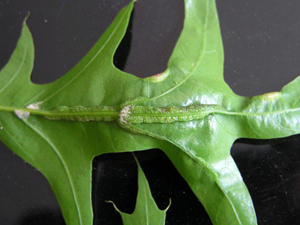Gall Forming Insects Plague Oak Trees and Can Lead to Itch Mite Concerns
Return to Trees and Shrubs Agent Articles
 One of our most common and beloved shade trees, the pin oak, can be plagued by an insect problem. Although nasty looking, this problem does not cause long term damage to the health of the tree. The most common gall forming insect is called vein gall.
One of our most common and beloved shade trees, the pin oak, can be plagued by an insect problem. Although nasty looking, this problem does not cause long term damage to the health of the tree. The most common gall forming insect is called vein gall.
In early spring as the leaves are unfurling, this small wasp-like insect, or psyllid, stings the developing leaf injecting a growth regulator which forms a home for its eggs and future stages of growth. As the leaf develops the results of this insect can be seen by the twisting and curling of oak leaves, often resulting in a hard ridge running down the veins of the leaf, hence the name vein gall. This is the most common gall-forming insect in our area.
There are numerous types of gall-forming insects that attack oak trees. They all result in some form of bump, nodule or growth developing on the leaf. Another less common gall is one that stings on the margin of the leaf causing it to roll over. This gall is referred to as margin gall. While most types of galls are harmless this one may cause issues due to a mite that feeds on this small insect.
Although galls look bad, they cause no health problems to the tree. The formed galls result in the misshapen leaves. The adult stages of galls are small gnat-like insects called psyllids. Psyllids sting the leaves in the spring as they are unfolding. This sting results in the gall formulation in which the egg is laid. Later in the summer, this egg hatches and the small larvae fall to the ground to pupate.
There is really no way to prevent this insect from damaging the tree leaves. Insecticide sprays are not recommended as control of the adult insect is difficult. Effective sprays would need to cover the expanding leaves over a several week period. This would result in excess use of chemicals.
As already stated, this insect problem does not compromise the health of the tree. This is another good reason not to treat. Leaves severely affected by the curling will reduce photosynthesis, but not enough to damage the tree’s health. Damaged leaves will not recover and will slowly drop from the tree over the summer and fall months.
The question is will this happen again next year? We really never know. As with most insect populations, they tend to cycle. So relax, there are worse problems that could appear. Chalk this vein gall up to nature and marvel at the unique way that some insects survive.
Oak Itch Mite Associated with Galls
Researchers have determined there is a relationship with the gall referred to as margin gall. They have determined a mite feeds on the larvae. This mite is responsible for the rashes and bites that people report receiving while working or playing around oak trees.
Oak itch mites cause discomfort to those bitten. Many compare the bite to that of a chigger, but there are many more bites associated with the itch mite. Complete information on identification and ways to reduces itch mites bites can be found in this K-State publication: Oak Leaf Itch Mite.
The question the office receives is about whether or not the itch mite will be present in large numbers this fall. That is an extremely difficult question to answer as there are many factors. We do know there is a relationship between specific gall formation and the itch mite. These galls are present this summer which could mean the itch mite will return.
Our office has also had reports of people being bitten over the summer months by the itch mite. At this time it is a guessing game about how severe the itch mite population may be this fall. Our best recommendation is to take the necessary steps to prevent bites when working out in the yard this summer and fall, especially if there are a number of oak trees in the neighborhood.
Contact Us